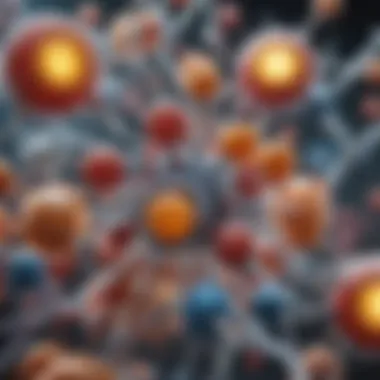LHRH Agonist Drugs: Mechanisms and Applications


Intro
LHRH agonist drugs form a vital part of modern therapeutics, particularly in the management of hormone-sensitive conditions. From treating prostate cancer to addressing endometriosis, these compounds harness the natural mechanisms of hormone regulation within the body. Understanding how these drugs work and their applications across various fields of medicine is essential for both practitioners and students alike.
The allure of these drugs lies in their sophisticated interaction with the hormonal pathways. LHRH, or Luteinizing Hormone-Releasing Hormone, plays a crucial role in signaling the pituitary gland to produce luteinizing hormone (LH) and follicle-stimulating hormone (FSH). When we introduce agonists into the system, it's not just a simple switch; it's a complex dance between suppression and stimulation of these hormones, leading to various clinical outcomes.
In spite of their potency, the use of LHRH agonists comes with its own set of challenges, such as potential side effects that practitioners must weigh carefully. As more is uncovered about these drugs, it’s clear that the horizon for LHRH-related therapies is expanding. \n \nLet's delve deeper into the intricacies of these medications to unveil their mechanisms and explore the spirited discussions surrounding their applications in contemporary medicine.
Overview of LHRH Agonists
LHRH agonists, or luteinizing hormone-releasing hormone agonists, are pivotal players in the realm of endocrinology and oncology. Their significance arises from their ability to modulate hormonal pathways that are critical in various physiological functions, impacting conditions ranging from prostate and breast cancer to endometriosis. The importance of understanding LHRH agonists cannot be overstated—they offer solutions to complex hormonal disorders and are integral in the development of treatment strategies that improve patient outcomes.
Definition and Mechanism of Action
At its core, an LHRH agonist mimics the action of natural luteinizing hormone-releasing hormone. When administered, these compounds initially act in a stimulatory fashion, promoting the release of sex hormones such as testosterone and estrogen. However, continued exposure leads to a desensitization of the hypothalamus, ultimately resulting in a decrease in hormone levels. This biphasic action is crucial for the therapeutic management of hormone-sensitive conditions.
- Key Steps in Mechanism:
- Initial Stimulation: The agonist stimulates the anterior pituitary to release LH and FSH.
- Desensitization: Over time, the persistent signaling reduces the sensitivity of the pituitary gland.
- Suppression of Hormones: Finally, the levels of circulating sex hormones drop, providing therapeutic benefits.
This unique mechanism not only aids in the treatment of hormone-dependent tumors but also offers advantages in managing other conditions like endometriosis, where excessive hormone levels can cause severe complications.
Historical Context
The development of LHRH agonists can be traced back to the 1970s when the structural analogs of natural LHRH were synthesized to harness its regulatory functions. Initial research paved the way for the first agonists, which showed promising results in treating prostate cancer. Over the decades, further studies have illuminated the potential of these drugs, expanding their application in various fields of medicine. Understanding this historical backdrop showcases the trajectory of medical innovation in hormonal therapies, underscoring how far we've come in leveraging human biochemistry to combat disease.
Predictably, the journey wasn't without challenges. Early versions of LHRH agonist treatments met with mixed results, characterized by a learning curve in understanding dosing regimens and timing of administration. Nonetheless, the continuous refinement of these therapies led to the sophisticated LHRH agonists we recognize today, with enhanced efficacy and reduced side effects.
"The evolution of LHRH agonists stands as a testament to the progress made in the field of hormonal therapy, encapsulating decades of research and clinical trial data that supports their use in modern medicine."
As the understanding of hormonal interactions deepens and technologies evolve, LHRH agonists remain at the forefront of research, hinting at potential new applications and refined approaches in treating hormone-sensitive conditions.
Types of LHRH Agonists
Understanding the different types of LHRH agonists is crucial, as this knowledge lays the foundation for recognizing how these compounds can be utilized across various therapeutic landscapes. Each agonist possesses unique characteristics, and their classifications can vary based on factors such as chemical structure, administration routes, and therapeutic use. This section delves into the clinical classifications of LHRH agonists and conducts a comparative analysis, highlighting their diverse applications and implications in medical practice.
Clinical Classifications
LHRH agonists can be broadly classified into several distinct categories based on their clinical applications and properties. Each type serves a specific purpose in managing hormone-sensitive conditions. Here are some primary classifications:
- Short-acting Agonists: These are typically administered daily or in shorter intervals. Drugs like Leuprolide fall into this category, often used in the treatment of prostate cancer by inducing a temporary increase followed by suppression of testosterone levels.
- Long-acting Agonists: Designed for less frequent administration, these agonists are injected on a monthly or quarterly basis. An example of this is Goserelin, used for both prostate cancer and endometriosis. Their prolonged action helps patients comply with treatment regimens.
- Depot Formulations: Depot formulations are often employed for prolonged release of the drug into the system. They maintain steady levels of the medication over an extended time and reduce the need for frequent dosing.
- Ultrashort Agonists: Newer formulations, aimed at rapidly achieving hormonal suppression, showcase advancements in drug design. One such example is Histrelin, which acts quickly to inhibit testosterone and estrogen production.
Each of these classifications has its place in therapy, with advantages and drawbacks that can impact patient outcomes. For example, shorter-acting agonists may provide rapid control of symptoms but require greater adherence and patient involvement, while longer-acting formulations may suit those who prefer less frequent appointments and injections.
Comparative Analysis of Various Agonists
When comparing LHRH agonists, it's essential to examine their biochemical actions and clinical impacts. The differences boil down to their efficacy, side effects, and specific uses:


- Leuprolide vs. Goserelin: Both are effective in treating hormone-sensitive cancers, but Leuprolide typically requires daily dosing, whereas Goserelin can be administered monthly. This difference in administration can influence patient adherence significantly.
- Histrelin’s Rapid Action: Its ultrashort nature allows for swift hormonal suppression, benefitting urgent clinical situations, such as severe endometriosis-related pain. However, its short action necessitates frequent injections, which may be less convenient for long-term management.
"Not all LHRH agonists are created equal; their diverse profiles lead to a spectrum of clinical implications."
- Comparative Side Effects: Side effects vary between agonists. While most share common adverse reactions like hot flashes and mood changes, some may present additional risks depending on the patient's health status and the specific drug's pharmacology.
- Cost and Accessibility: Another critical comparison factor is the cost of these drugs, which can vary considerably. In some healthcare systems, this could drive the choice between one agonist and another, affecting treatment decisions.
This comparative analysis shows the dynamic landscape of LHRH agonists, underscoring the need for personalized treatment approaches in managing hormone-dependent conditions. Understanding these classifications and their distinctions informs clinicians' decisions and optimizes patient outcomes.
Therapeutic Applications
LHRH agonist drugs hold a significant place in modern medicine due to their versatile therapeutic applications across various medical fields. The importance of these drug compounds lies not just in their pharmacological effects, but also in their ability to address hormone-sensitive conditions effectively. By modulating the pituitary gland's release of luteinizing hormone and follicle-stimulating hormone, LHRH agonists influence numerous biological processes, opening avenues for treating a range of pathologies. Understanding their therapeutic applications can empower healthcare providers to make informed decisions based on patient needs and specific medical scenarios.
Oncology: Prostate and Breast Cancer
In oncology, LHRH agonists specifically demonstrate their value in managing hormone-sensitive tumors, such as prostate and breast cancers. These agonists function by suppressing the secretion of gonadotropins, which leads to a decrease in testosterone production in men and estrogen levels in women.
- Prostate Cancer: The role of LHRH agonists like leuprolide and goserelin is notable in prostate cancer management. By inhibiting testosterone, they help shrink tumors and alleviate symptoms associated with advanced disease. Research shows that when combined with other therapies, they can significantly improve survival rates in advanced-stage cases.
- Breast Cancer: Similar principles apply to breast cancer treatment in premenopausal women. By lowering estrogen levels, LHRH agonists can reduce tumor size and slow disease progression. Moreover, studies indicate that in conjunction with aromatase inhibitors, these agonists enhance treatment efficacy, paving the way for innovative therapeutic combinations.
Endometriosis and Uterine Fibroids
When exploring conditions like endometriosis and uterine fibroids, the use of LHRH agonists offers another layer of treatment potential. Endometriosis, marked by the abnormal growth of endometrial tissue outside the uterus, often leads to chronic pain and infertility. LHRH agonists help manage these symptoms by inducing a temporary state of menopause, thus reducing estrogen levels and, therefore, the menstruation cycle itself.
Conversely, for uterine fibroids, these agonists can shrink fibroid size considerably, potentially delaying or removing the need for surgical interventions.
"LHRH agonists effectively function as hormonal manipulators, creating a therapeutic window for women suffering from endometriosis and fibroids, hence reducing the burdens of these conditions."
Assisted Reproductive Technology
In the landscape of assisted reproductive technology (ART), LHRH agonists also play a pivotal role. They are commonly used in controlled ovarian stimulation protocols. By controlling the timing of ovulation and the development of multiple follicles, these drugs optimize conditions for egg retrieval.
- Ovarian Hyperstimulation: Through their regulation of endogenous hormone levels, LHRH agonists help prevent premature ovulation, allowing for successful egg collection.
- IVF Success Rates: Some studies suggest that adding LHRH agonists to traditional treatment protocols can improve IVF success rates, as they help in properly aligning the physiological cues necessary for maturation and implantation.
Understanding these therapeutic applications not only emphasizes the efficacy of LHRH agonist drugs but also nurtures an awareness of their multifaceted roles in addressing significant health concerns. Each application underscores a deeper conversation about patient-focused treatment strategies and encourages continued research into novel uses.
Pharmacokinetics and Pharmacodynamics
Understanding pharmacokinetics and pharmacodynamics is critical when we analyze the functionality and effectiveness of LHRH agonist drugs. These two intertwined scientific realms help us understand how these drugs behave within the body and their subsequent effects. By delving into how these substances are absorbed, metabolized, and how they exert their hormonal impact, we can see their real clinical implications in treating various conditions.
Absorption and Metabolism
When an LHRH agonist enters the body, its journey starts with absorption. This process can vary based on the route of administration—subcutaneous injections, for instance, allow for a direct entry into the bloodstream, while oral formulations must go through the digestive system. The rate and efficiency of absorption plays a significant role in the drug's overall effectiveness. It's not just about the amount that enters the bloodstream, but how quickly it reaches peak levels.
After absorption comes metabolism, which ensures that the drug is broken down properly. Most LHRH agonists are metabolized primarily in the liver. Here, enzymes can alter the drug's structure, creating metabolites that may be active or inactive. The rate of metabolism could affect the duration of action of the drug. In certain cases, a slow metabolism means prolonged activity, which raises interesting considerations in treatment regimens. The pharmacokinetic profile of each agonist can differ, affecting dosing strategies and treatment outcomes.
Impact on Hormonal Regulation
Once in circulation, LHRH agonists exert their action by mimicking natural hormones. They bind to receptors within the pituitary gland and pituitary hormones get produced in response. This prompts a series of biological changes that affect hormone levels throughout the body. Essentially, it’s a delicate balancing act, as the agonists mimic the physiological signals that manage reproductive functions and other bodily processes.


One critical aspect to consider is the concept of downregulation. When LHRH agonists are administered over time, the body's feedback mechanism responds by reducing production of certain hormones like luteinizing hormone and follicle-stimulating hormone. This reduction is particularly relevant in treating hormone-sensitive cancers, where lowering the hormone levels can help shrink tumors or slow their growth.
As such, LHRH agonists demonstrate a unique and strategic method of manipulating the endocrine system, highlighting their potential across diverse medical fields.
Their impact goes beyond just clinical outcomes; it extends to the patients' overall health and quality of life. It’s crucial to understand that while this modulation can be beneficial, it can also lead to unwanted effects, further emphasizing the importance of monitoring and managing therapy closely.
In summation, blending pharmacokinetics with pharmacodynamics elucidates how LHRH agonists navigate the complex landscape of the human body. Their ability to modify hormonal inputs can be a powerful tool in modern medicine, but it requires careful consideration and ongoing research to get the balance just right in therapeutic settings.
Side Effects and Risks
Understanding the side effects and risks associated with LHRH agonist drugs is crucial for both medical practitioners and patients alike. These medications can provide significant therapeutic benefits, yet it’s equally important to be aware of their potential downsides. This section aims to highlight common adverse reactions and long-term complications, emphasizing the necessity for informed decision-making by discussing the balance between benefits and drawbacks that these drugs may present.
Common Adverse Reactions
LHRH agonists are generally well-tolerated, but like any medication, they come with a risk of side effects. Some of the more frequently reported adverse reactions include:
- Hot Flashes: This symptom, akin to what many experience during menopause, can be uncomfortable and distracting.
- Mood Changes: Patients might notice fluctuations in their mood, ranging from mild irritability to more pronounced emotional responses.
- Weight Gain: Some have found that using these drugs over time contributes to weight increase, something that can affect self-esteem and overall health.
- Decreased Libido: Changes in sexual desire and function can occur, which might impact personal relationships.
“Potential side effects must always be weighed against therapeutic gains.
Drugs that can help fight severe health issues may come with unwanted companions.”
These reactions can vary in severity among different patients, influenced by individual health statuses and concurrent treatments. Regular monitoring by healthcare professionals is advisable to manage these effects proactively and improve the quality of life for patients undergoing treatment with LHRH agonists.
Long-term Complications
While many side effects are manageable, long-term use of LHRH agonists may lead to more serious complications. These include:
- Bone Density Loss: Prolonged exposure to these medications can initiate a decline in bone density, increasing the risk of fractures and osteoporosis. Regular bone density assessments can help in early detection.
- Cardiovascular Risks: Some studies suggest a potential link between prolonged LHRH agonist use and increased cardiovascular events. This emphasizes the need for cardiovascular risk assessment in patients receiving these therapies.
- Metabolic Changes: There is evidence that this class of drugs can lead to alterations in glucose metabolism, possibly raising the risk for diabetes in susceptible individuals.
In essence, while LHRH agonists are invaluable for managing hormone-sensitive conditions, awareness of their potential long-term risks is paramount. Regular check-ups and a dialogue between patients and healthcare providers can make a significant difference, ensuring that any emerging concerns are addressed promptly.
Current Research and Developments
The exploration of LHRH agonist drugs continues to be a significant area of research, particularly as new medical challenges arise and technologies advance. Understanding the dynamics of these drugs is not merely academic; it translates into real-world applications that can improve patient outcomes. Active research efforts delve into innovative drug designs and novel applications that broaden the therapeutic scope of LHRH agonists.
Innovative Approaches in Drug Design
Recent advancements in drug design are paving the way for modified LHRH agonists that have enhanced specificity and reduced side effects. Researchers are experimenting with various chemical modifications to increase the potency and extend the half-life of these agents. For instance, scientists have developed peptide analogs that mimic the natural hormone with better binding efficiency to receptors, which may result in more potent therapeutic effects.
Additionally, nanotechnology is playing a crucial role in this area. By utilizing nanoparticles as carriers, researchers aim to directly target tissues affected by conditions like cancer, thereby minimizing systemic side effects. This method not only improves the concentration of the drug at the site of action but also reduces the overall required dosage, which can lead to fewer adverse reactions for patients.
Moreover, researchers are looking into combination therapies, pairing LHRH agonists with other pharmacological agents to tackle cancers that exhibit resistance to traditional treatments. These approaches can hit multiple pathways, lowering the chance of tumors developing resistance.
"Innovative drug design offers a glimpse into a future where LHRH agonists could be more effective and patient-friendly, dramatically changing treatment paradigms."
Emerging Applications in New Indications
The potential applications of LHRH agonists extend beyond established treatments for prostate cancer, breast cancer, and endometriosis. Emerging research is revealing their usefulness in several other indications, an example being polycystic ovarian syndrome (PCOS). Studies suggest that LHRH agonists might regulate hormonal imbalances commonly seen in PCOS, possibly leading to improved fertility outcomes and metabolic health.


Furthermore, developments in autoimmune diseases have sparked interest in using LHRH agonists to modulate immune responses. This could open up avenues for treating conditions like rheumatoid arthritis, where hormonal regulation is known to play a crucial role.
Ongoing clinical trials are investigating their efficacy in schizophrenia as well. The underlying hypothesis suggests an interplay between hormonal pathways and neuropsychological symptoms. If proven successful, this could lead to groundbreaking changes in how some mental health conditions are approached therapeutically.
In summary, the field of LHRH agonists is teeming with promise. The innovative designs and expanding indications signify a rich landscape for future exploration, potentially transforming the therapeutic capabilities of these drugs. As research progresses, staying updated on these developments is important for anyone involved in healthcare or related fields.
Future Directions
Exploring the future directions of LHRH agonist drugs is essential for both current and aspiring professionals in the medical and research fields. As we venture deeper into understanding these substances, there is a pressing need to analyze potential paths for advancement. Such improvements in therapy, while promising, hold implications that extend into practical applications and ethical considerations. Analyzing future trajectories not only enhances clinical practices but also broadens the horizons for investigative research.
Potential Advances in Therapy
Potential advances in therapy with LHRH agonists cover several pivotal areas. Firstly, the refinement of drug formulations can lead to better patient compliance and outcomes. For instance, prolonged-release versions of current LHRH agonists could minimize the frequency of administration, thus reducing patient burden.
Moreover, ongoing studies are likely to uncover new indications for therapy. Recent trends indicate a potential expansion into areas like metabolic disorders or non-oncological conditions. In this light, the long-term impact of LHRH agonists could reshape their application landscape.
- Ongoing research has also hinted at modified molecules with enhanced specificity and reduced side effects.
- This tailored approach promotes individualized medicine, ensuring patients receive the most suitable treatment designed for their unique hormonal profiles.
Companies are investing considerably in innovative delivery systems. Technologies, such as implantable devices or oral formulations, might revolutionize how these drugs are administered. Notably, the use of wearable tech can facilitate monitoring and adjustments in real-time.
"The potential is indeed profound, pushing the boundaries of what we thought was achievable with LHRH agonists."
Challenges and Considerations
As with any advancing field, challenges and considerations come into play. The complexity of hormonal systems means that any new application of LHRH agonists requires rigorous evaluations. Researchers must navigate intricate pathways of hormonal interactions to predict outcomes accurately.
Additionally, ethical dimensions surrounding new applications are vital. As these drugs expand into broader therapeutic areas, patient consent and understanding must be prioritized. Medical professionals must foster transparent communication about risks, benefits, and the experimental nature of these directions.
Other possible obstacles include:
- Regulatory Hurdles: Gaining approval for new formulations or indications can be a protracted process, often requiring years of thorough testing.
- Cost Implications: Development and production costs for novel therapies could straddle the line between accessibility and profitability, affecting healthcare systems across various demographics.
- Public Perception: As with any emerging medical strategy, how society views LHRH agonists and their new roles will significantly influence their integration into standard practice.
In summary, while the future of LHRH agonists promises much, it is not without hurdles. The insights gained will prove invaluable in crafting therapies that are not only effective but also ethically responsible. As we consider what lies ahead, the commitment to enhancing patient care remains paramount.
Epilogue
The examination of LHRH agonist drugs is not just an academic exercise. It serves to elucidate their profound significance in contemporary medicine, a field that is continually evolving. These agents, pivotal in managing hormone-sensitive conditions, reflect how nuanced pharmacology can change health landscapes. The overall contributions of LHRH agonists extend beyond mere hormonal modulation; they have reshaped treatment paradigms, addressing complex diseases ranging from various cancers to reproductive health issues.
Summary of Key Insights
Throughout this article, several vital insights regarding LHRH agonists emerge:
- Mechanisms of Action: Understanding how LHRH agonists interact with the endocrine system helps healthcare professionals better tailor treatments and manage patient expectations.
- Clinical Applications: These drugs are foundational in oncology, particularly in managing prostate and breast cancer, as well as conditions like endometriosis. Their diverse applications demonstrate their versatility.
- Side Effects and Risks: Like any treatment, LHRH agonists are not without their drawbacks. Recognizing common and long-term complications is essential for informed clinical decisions and to enhance patient care.
- Future Directions: Ongoing research into novel applications reveals a promising future for these drugs. Clinicians must stay informed about advancements that could widen therapeutic uses and improve outcomes for patients globally.
Focusing on these aspects enhances our understanding of LHRH agonists and fosters an appreciation for their role in modern medicine.
Ongoing Impact on Medical Practice
The implications of LHRH agonist drugs are conspicuous and ongoing in medical practice. Their introduction has not only changed treatment modalities but also stimulated further research and development within endocrinology and oncology. Improved knowledge and understanding of these drugs lead to tailored therapies that can potentially minimize side effects while maximizing therapeutic benefit.
An evolving awareness around hormone-related diseases has influenced medical education and training, ensuring that new generations of healthcare providers are well-versed in the nuances of hormonal therapies. As clinical guidelines shift, based on fresh evidence, practitioners are encouraged to adopt a patient-centered approach, weighing both the risks as well as benefits of these pharmaceuticals.
"The magic of medicine lies in the balance between the art of understanding patients and the science of pharmacology."
In summary, the LHRH agonists play an indispensable role in the intricate interplay of hormones and disease treatment, continuously leaving a mark on how conditions are approached and mitigated. The conversation surrounding their use is far from static; as more insight grows around their mechanisms, benefits, and potential drawbacks, one can anticipate further integration into standard clinical practices in the near future.







